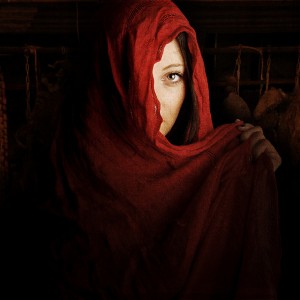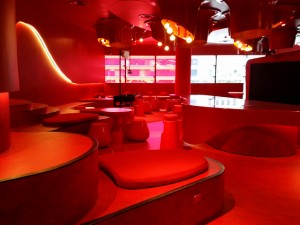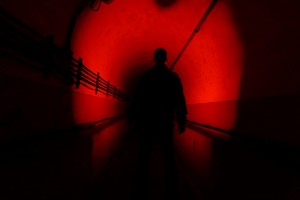The colour red makes us more attractive and stupid.
Valentine’s day is here and we are overloaded with all things red, the colour of love and lust. As a behaviour designer, this makes me wonder: Does red make us more ‘romantic’ or is it just a commercial craze? What is the red effect?
We know from research that subtle, even subliminal cues can have a real impact on behaviour. Is that also true for colour?
Colour psychology is still an underdeveloped area and you should be wary of some of the claims as they can be somewhat superficial and unsubstantiated. Still, scientific evidence suggests that red makes you look more sexually attractive and more successful.
Colour of love
Wearing red affects how people see you. Psychologists Elliot and Kayser (2010), found that men see women as more attractive and sexually desirable when they are wearing red, as opposed to other colours. Nicolas Guéguen (2012) put this finding to the test in a bar. He asked female accomplices to wear red, pink or brown lipstick, or none at all, while sitting at a bar.  The findings were amusing: Men approached women in red lipstick fastest and most often. He found a similar effect in a restaurant. A waitress who wears red gets higher tips from men, while women still tip the same (Gueguen & Jacob, 2012).
The findings were amusing: Men approached women in red lipstick fastest and most often. He found a similar effect in a restaurant. A waitress who wears red gets higher tips from men, while women still tip the same (Gueguen & Jacob, 2012).
Fortunately, women are not immune either. Men who wear red are seen as more dominant, more attractive and more sexually desirable by women. They are not seen as more likeable, or extraverted. Unfortunately, this finding has not been tested in a bar or restaurant yet.
Wearing red also affects your chances of winning at sports. Evolutionary anthropologists Hill and Barton analysed the outcomes of boxing and wrestling matches in the 2004 Olympics and international soccer games. It is important to note that colours of outfits are randomly assigned, so the chances of winning should be even. However, athletes wearing red won more fights and matches than those in blue.
None of the people in these studies knew about the purpose of the tests and were unaware of any colour differences afterwards.
Seeing red
So red affects how other people see you, but how does it affect you when you see red things or spaces? Well, some scientific findings are rather strange.

As it turns out, we eat and drink less from red cups and plates than when they are blue (Genschow, Reutner, & Wänke, 2012). Also, in shops with a red interior we spend less time, take longer to buy something and we buy less (Belizzi & Hite, 2009). When we are in pain, red makes it worse.
What surprised me most was that in several experiments, people who had seen red performed worse on exams, IQ tests and creativity tasks afterwards (Elliot, Maier, et al., 2007). How is this possible?
How can we explain the red effect?
There are two explanations for why we respond to the colour red.
One explanation is that red is hardwired in our brain through evolution. Red is a biological signal of male status and health; and female fertility in a range of animals. A study with humans found that men with higher testosterone levels indeed prefer red over blue (Farrelly, 2013). This might explain why we are also attracted to people who wear red.
The second explanation is that we have learned to associate red with danger and error (red ink, blood, stop signs, and warning lights). Seeing red actually arouses us and our muscles react faster and more forceful. Our brain also responds by activating what’s called avoidance motivation. Avoidance motivation is the opposite of approach motivation, they are like a mild mental version of the fight or flight response. Red, by triggering avoidance, makes our brain more vigilant and risk averse (Mehta & Zhu, 2009). We focus on the concrete things right in front of us, instead of the bigger picture and we avoid trying new things to solve problems. We put in less effort in what we do and avoid difficult tasks. This might explain why we engage less with red things and why we do worse in tests after seeing red. Our brain tells us to stay away.
So what does the red effect mean for design?
So if the colour red can have such strong and subconscious reactions 
in people, how should we apply red in design? And how should we deal with the fact that red sometimes attract us and sometimes scares us away? The most important lesson is that context matters. Red is a good colour in fashion design, and it is a good colour if you want to draw attention to something important, but it might be difficult to convert that attention into action. I would also advise against using red in the design of healthcare spaces and rooms where you want people to be open and creative. It’s ok to make red products for valentine’s day, because the context is romantic. Perhaps, it is not the best idea to go overboard with decorating your shop with Valentine gifts. You will actually sell less…
Still, I know what I’ll be wearing today….;-)
Spread the love and share these tips with your friends
references
Environmental color, consumer feelings, and purchase likelihood. Bellizzi, J. A. & Hite, R. E. Psychol. Mark., 9: 347–363. 1992, doi: 10.1002/mar.4220090502
The color red reduces snack food and soft drink intake. Genschow, O., Reutner, L., & Wänke, M. Appetite, 58(2), 699-702. 2012 http://www.sciencedirect.com/science/article/pii/S0195666311006957
Message framing and color priming: How subtle threat cues affect persuasion. Gerend, M. A., & Sias, T. Journal of Experimental Social Psychology, 45(4), 999-1002. 2009 http://www.sciencedirect.com/science/article/pii/S0022103109000821
Color and psychological functioning: The effect of red on performance attainment. Elliot, A. J., Maier, M. A., Moller, A. C., Friedman, R. & Meinhardt, J. Journal of Experimental Psychology: General, Vol 136(1), 154-168. (2007). http://dx.doi.org/10.1037/0096-3445.136.1.154
Red, rank, and romance in women viewing men. Elliot, Andrew J.; Niesta Kayser, D. Greitemeyer, Tobias; Lichtenfeld, Stephanie; Gramzow, Richard H.; Maier, Markus A.; Liu, Huijun. Journal of Experimental Psychology: General, Vol 139(3), 399-417. 2010. http://dx.doi.org/10.1037/a0019689
Blue or red? Exploring the effect of color on cognitive task performances. Mehta, R., & Zhu, R. J. Science, 323(5918), 1226-1229. 2009. http://science.sciencemag.org/content/323/5918/1226.short
Color in context: Psychological context moderates the influence of red on approach-and avoidance-motivated behavior. Meier, B. P., D’agostino, P. R., Elliot, A. J., Maier, M. A., & Wilkowski, B. M.PloS one, 7(7), e40333. (2012).
Romantic Red: Red Enhances Men’s Attraction to Women. Andrew J. Elliot and Daniela Niesta in Journal of Personality and Social Psychology, Vol. 95, No. 5, pages 1150–1164; November 2008.
Does Red Lipstick Really Attract Men? An Evaluation in a Bar. Nicolas Guéguen in International Journal of Psychological Studies, Vol. 4, No. 2, pages 206–209; June 2012.
Sporting Contests: Seeing Red? Putting Sportswear in Context. Candy Rowe, Julie M. Harris and S. Craig Roberts in Nature, Vol. 437, page E10; October 27, 2005.
Clothing Color and Tipping: Gentlemen Patrons Give More Tips to Waitresses With Red Clothes. N. Gueguen & C. Jacob. Journal of Hospitality & Tourism Research, 2012; DOI: 10.1177/1096348012442546
Competitors who choose to be red have higher testosterone levels. Daniel Farrelly et al. Psychological Science, 2013

Leave a Reply